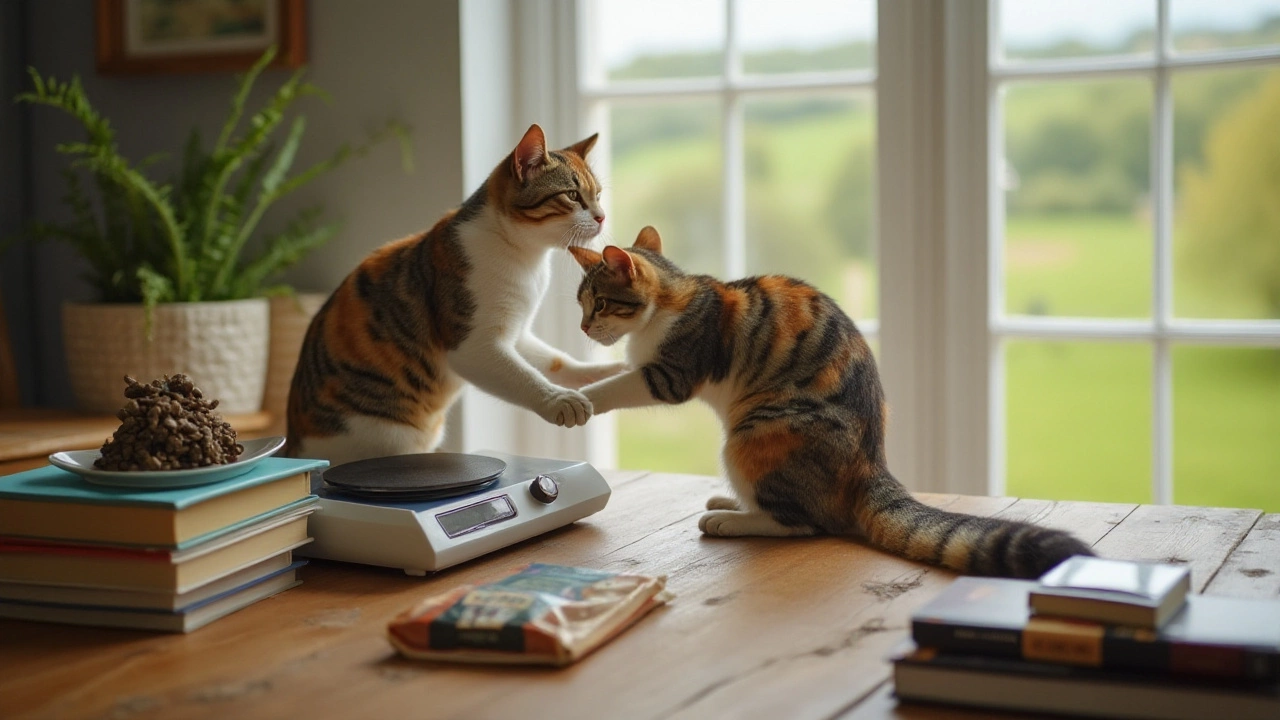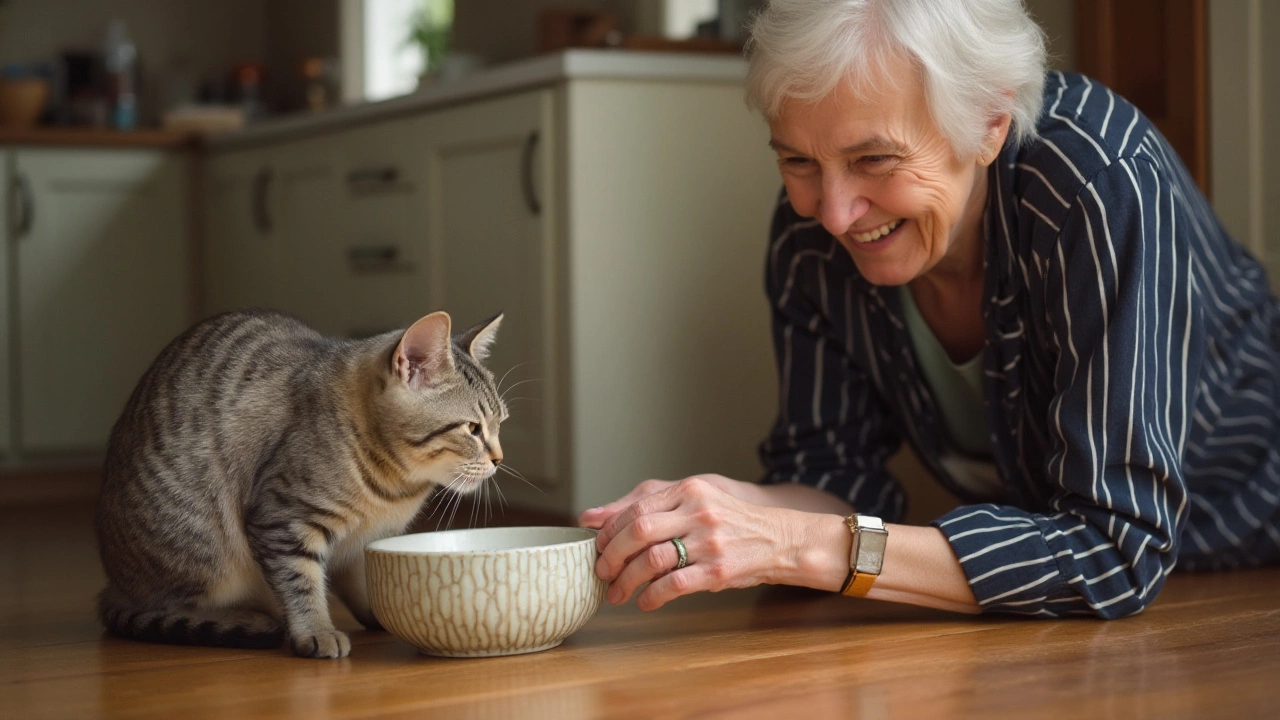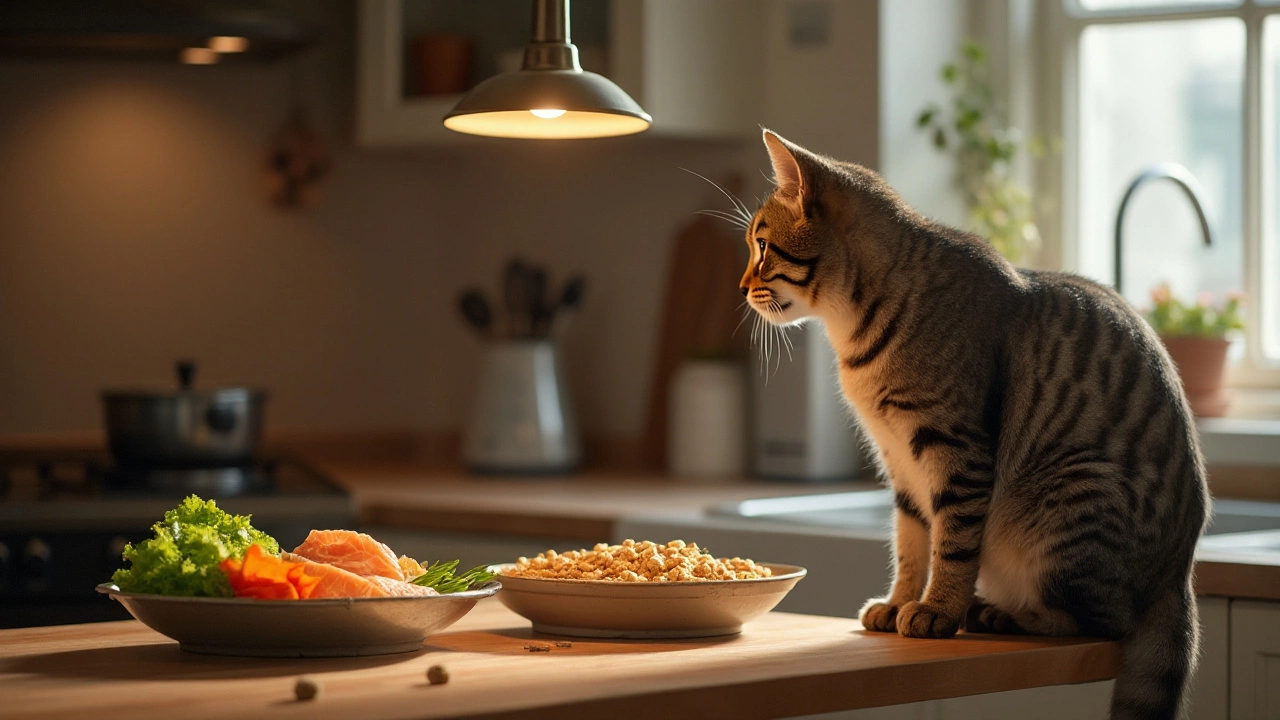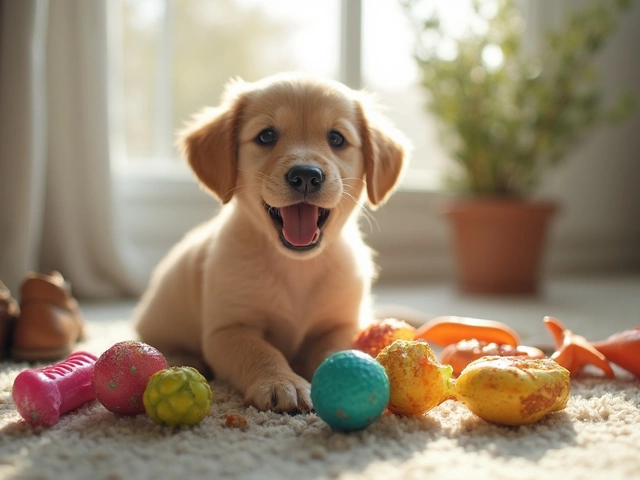Cats are fascinating creatures with a knack for keeping their owners on their toes, particularly when it comes to food. Have you ever pondered whether your feline friend knows when to call it a day on their kibble feast? It's a question many cat owners find themselves asking.
For cats, the sense of satiety, or knowing when they’re full, isn't straightforward. While they have instincts from their wild ancestry, domestic living has introduced complexities in their eating behaviors. Much is dependent on the kind of food they eat and how it's served.
Let's delve into how these beloved pets understand fullness, explore the elements that influence their eating, and see how you can help guide your furry pal towards healthier eating habits. Keeping an eye on your cat’s health and ensuring their meals meet nutritional needs can pave the way for a contented, well-fed friend.
- Understanding Feline Satiety
- Natural Instincts vs. Domestication
- Impact of Different Types of Cat Food
- Health Factors Influencing Eating Habits
- Recognizing Signs of Satiety in Cats
- Tips for Proper Feeding Practices
Understanding Feline Satiety
Deciphering whether cats recognize when they are full involves a look into their intricate biology and behavior. Unlike humans or other animals, cats primarily go by natural instincts and past evolutionary adaptations. For centuries, wild cats have relied on their instinctual prowess to hunt and consume food. This means that, in the wild, cats rarely face scenarios where they overeat, as their choices are dictated by availability and necessity. These instincts have been semi-retained in domesticated cats, leading many to wonder how much modern feline behavior is swayed by their ancestry.
Feline satiety – or the state of feeling full – involves several physiological signals that indicate to a cat when to cease eating. These signals are initiated by the fullness of the stomach, the release of hormones such as leptin, and feedback from their metabolism. For domesticated cats, knowing when they are full can get muddled by the accessibility of food and human intervention. An interesting aspect is that not all cats are equally good at detecting these signals. Factors such as individual metabolism, activity level, and even their relationship with their environment play key roles.
Much of a cat's dietary habits and satiety cues come from how they are raised and their everyday environment. For instance, studies have shown that cats on a diet of free-feeding dry food can develop a greater propensity to ignore satiety signals compared to those on set meal times of wet food. This is because the nature of the food affects how cats digest and perceive fullness. According to Dr. Jane Brunt, a veterinarian emphasizing feline care, "Cats exhibit a mix of hunting and eating behaviors in domestic settings, making meal regulation pertinent to their health." Understanding these cues is crucial for any cat owner, as it might prevent health issues such as obesity.
Pet owners observing their cats may notice a range of individual behaviors when it comes to feeding. Some work on the ‘nibble’ method, returning to their bowls multiple times a day, while others may gobble up all that is available in one go. The gambit of behaviors also presents the use of 'auto-regulation', a term where cats supposedly manage their intake over a day, balancing calories as they require. Yet, the debate on whether domesticated cats auto-regulate effectively as wild cats remains active among experts.
Scientific data posits that feeding frequency, along with the combination of food texture and consistency, may affect a cat's satiety levels. A study by Cornell University illustrates that offering more frequent, smaller meals can align more closely with a cat’s natural hunting-fasting cycle, potentially enhancing their ability to comprehend satiety. This aligns with a multi-meal regimen that seeks to keep cats both mentally and physically stimulated.
With these aspects in mind, understanding and fostering proper feline diet practices is imperative. Cat owners need to be observant and accommodating towards their pets’ dietary behaviors. Encouraging a routine and adopting measured meal servings can bridge the gap between a cat's primal instincts and modern lifestyle, aiding them in recognizing their fullness signals efficiently. Adopting such practices promotes a happy and healthy household where cats thrive.
Natural Instincts vs. Domestication
Cats, whether they're prowling through the wild or lounging in a cozy living room, are enigmatic creatures with a strong presence in both their natural instincts and their adaptation to domesticated life. Throughout history, cats have carried with them the fundamental behaviors of their wild ancestors, such as hunting, territory marking, and survival tactics. These behaviors are deeply rooted in their DNA and manifest in various aspects of their daily lives, including how they approach food and feeding. However, when they transition from the wild into our homes, some of these instincts undergo modifications due to altered environments and human influence.
In the wild, felines are obligate carnivores and their diet is mainly hunting-driven, providing them with the necessary nutrients through fresh prey. This natural cycle typically keeps their eating patterns regulated— the presence or absence of prey determines their consumption. They hunt, eat, and repeat, seldom overeating since the chase itself is metered by the availability of prey. Instinctively, they know when to hunt less vigorously once their energy reserves are replenished. However, once domesticated, these cats no longer chase their meals. Food suddenly becomes readily available, doling out an open invitation for potential overeating, especially when tempted by delicious store-bought cat food that doesn't require the same energy expenditure.
Domesticated cats often find themselves at the mercy of human feeding habits which might not always align with their natural inclinations. Many cat owners prefer to leave food out all day long, providing unlimited access to meals. While this might cater to a felines' grazing tendencies, it can conflict with their primal instincts, causing confusion between actual hunger and habitual eating. This shift in feeding practices may lead to health concerns like obesity, an issue less common in their wild counterparts. A study published in the Journal of Feline Medical and Surgery found that domestic cats could be up to 20% heavier than those living in the wild, underscoring the impact of domestication on their eating habits.
In their book "Cat Sense: How the New Feline Science Can Make You a Better Friend to Your Pet," renowned animal behaviorist John Bradshaw highlights, "Living alongside people has led cats to modify their behavior in ways that we’ve only just begun to fully understand. However, they remain only partially tamed. Their instincts are still remarkably active."
Interestingly, some innate behaviors thrive even in domesticated environments. Cats may still engage in 'hunting'—stalking toys or insects indoors. Post-hunt, they may mimic feeding rituals, showing how instincts weave into their daily domestic life. In tuning into these actions, owners become key players in ensuring their cats maintain a semblance of their ancestral eating style. Feeding them in a way that aligns more closely with their dynamic history can involve replicating scenarios where the cat 'works' for its food, such as using food puzzles or timed feeders. Encouraging natural food-seeking and hunting behavior even while indoors can better satisfy the strong instincts that housecats still possess.
Appreciating this balance between a cat's natural instincts and their domesticated lifestyle sheds light on their unique nutritional needs. Offering a diet that reflects their wild counterparts, high in protein and low in excess carbohydrates, can mimic the health benefits of a natural diet. As responsible pet owners, understanding this dynamic can guide decisions in how and what we feed, ensuring that our feline friends remain healthy and happy, living comfortably despite the constraints of modern living.

Impact of Different Types of Cat Food
Diving into a cat's dietary world opens up a myriad of possibilities, where the type of food directly affects their satiety levels as well as their general health. At the basic level, cat food is generally categorized as either dry, wet, or raw. Each type has its own benefits and potential drawbacks, making it crucial for pet owners to understand what fits best for their feline companions.
Dry food, commonly known as kibble, is a popular choice due to its convenience and cost-effectiveness. It often boasts high carbohydrate content which, while providing energy, is not entirely ideal for obligate carnivores like cats. Despite its practicality, some cats may not feel as full after a meal of kibble due to its lower moisture content. This can potentially lead to overeating if not monitored properly. In a surprising twist, studies have shown that cats fed exclusively on dry-food diets tend to drink more water, indicating an innate attempt at compensating for moisture lack.
Wet food, with its higher moisture content, closely mimics a cat's natural prey intake. These types of food can help cats feel fuller due to the increased water volume, aligning more closely with their biological needs. The downside, however, is that these foods can be more expensive and spoil quickly if not consumed in one sitting. A fresh, appetizing meal might be something cats enjoy, but owners need to mind the balance between wet and dry food to ensure dental health remains a priority.
As Dr. Jennifer Coates, a prominent veterinarian, mentions, "Cats are naturally designed to get most of their moisture from their prey. When we feed dry food, there's a potential mismatch in their instinctual dietary needs."
Raw diets have gained popularity in recent years, thought to provide cats with a more natural feeding experience. These diets often involve a mix of raw meat, bones, and vegetables. Proponents argue it's the closest to a natural diet and can enhance a cat's coat health and energy levels. But it's not without risk. There are concerns about bacteria and parasites, and not every owner is comfortable or knowledgeable about how to prepare a balanced raw diet.
Cat owners considering a change in their pet's diet should consult with a veterinarian to tailor a plan that suits their specific cat’s health and lifestyle needs. Whether bringing in new cat food types or adjusting portions, a tailored approach can prevent common dietary issues like obesity or malnutrition. Ultimately, the right choice often depends on the cat's specific requirements, health status, and sometimes their own preferences.
Health Factors Influencing Eating Habits
Understanding a cat's appetite involves more than just looking at the amount of food in their bowl. Various health factors can have a significant impact on how and when a cat eats. As a start, a cat's age plays a crucial role. Kittens, with their rapid growth rate, require more frequent meals rich in nutrients, while a senior cat might need a diet that's easier to digest due to a slower metabolism. Chronic health conditions also influence eating habits. For instance, feline diabetes may necessitate a carefully monitored diet to manage blood sugar levels effectively. Additionally, dental health issues, like gingivitis or broken teeth, can make eating painful, leading to a reduction in food intake. Behaviorally, stress and anxiety can suppress a cat's appetite; changes like moving house or introducing a new pet can trigger such stress, altering their eating habits.
Cats are also less likely to adjust their eating habits purely based on illness, unlike other animals that might lose appetite when unwell. This means that often any change in eating can be a subtle clue to underlying health issues. A smart approach involves routine veterinary check-ups that can preemptively catch and manage these issues. In fact, veterinarians often advise that any new diet should take into account these factors to ensure it meets the nutritional needs of the cat’s current health status.
Dr. Rebecca Yates, a renowned veterinarian, says, "A cat's diet is pivotal in managing chronic conditions; feeding them appropriately not only alleviates symptoms but supports their overall wellbeing."Beyond physical health, spaying or neutering can also alter metabolism and activity levels, which then affect how much food the cat requires. After these procedures, appetite might initially drop but can increase as the cat’s body adjusts, so monitoring and adjusting portions becomes necessary to avoid weight gain. Cats are typically creatures of habit when it comes to meals, and disruptions to these habits should always be investigated. It’s remarkable how resilient yet sensitive cats are when it comes to their nutrition, which is why recognizing changes early can ensure they remain in peak condition despite the ebbs and flows of life.

Recognizing Signs of Satiety in Cats
In the mysterious world of feline behavior, understanding when your cat is satisfied after a meal can sometimes feel like deciphering an ancient script. Cats have subtle ways of telling us they're full, and learning to recognize these can prevent overeating, which often leads to obesity and other health issues. One of the clearest signals is when a cat walks away from its food bowl despite some food being left. This simple action is a cat's way of saying it's satiated. You'll notice your cat taking time to groom after a meal; this is another indicator that they're feeling comfortably full.
Another sign comes in the form of playful activity. If your cat is full, it may start engaging in play rather than returning repeatedly to its bowl. This is because a full belly provides energy, allowing your pet to indulge in its natural drive to hunt and play. Don't be surprised if after finishing up its meal, your cat finds its sunny spot for a rest. Lazily sprawling on the couch is equivalent to our post-dinner slump. Noticing this behavior helps you gauge your pet's satisfaction.
Pay attention to occasions when your feline friend eats slower than usual. A slow, deliberate pace can be a sign of being close to satisfied, giving you the opportunity to adjust portions accordingly.
"Cats, like people, need a certain amount of calories daily, and once they achieve this, they typically self-regulate," says Dr. Jane Brunt, a feline practitioner and executive director of the CATalyst Council. "Taking notice of how and when a cat eats gives incredible insight into their mood and overall health."Cats are creatures of habit, so any change in eating speed often tells a story about their feelings of fullness.
Beyond these habits, their body language is crucial. A content cat might engage in what's known as a 'slow blink', a sign of trust and happiness, that can often follow a good meal. Value these quiet moments as one of the many ways cats communicate with us. It's a truth that every cat owner seems to know in their bones: cats often sleep soundly after a meal. This isn't just from tiredness but contentment. A cat stretching out in its favorite spot after eating signals it's both full and at ease.
Monitoring your pet's bathroom habits provides additional clues. A reduction in trips to the litter box could mean your cat is eating just the right amount. On the contrary, more frequent visits might indicate overfeeding, prompting a need to reassess their diet regimen. An often overlooked but important detail is the condition of your cat's coat. A shiny coat denotes good nutrition and balanced meals. Maintaining awareness of these signs can keep your cat at a healthy weight, enriching its quality of life.
Of course, each cat's personality and habits are unique. Understanding the individuality of your furry companion's signals can adapt your feeding approach accordingly. These observations and modifications ensure your cat enjoys a balanced diet, leading to a happier, healthier life.
Tips for Proper Feeding Practices
Feeding your cat effectively combines art and science, ensuring their meals meet nutritional needs while also catering to their unique feline preferences. The foundation of proper cat nutrition lies in understanding their natural eating behaviors and incorporating that knowledge into daily feeding routines. Many cats thrive on regular schedules, as it mimics the predictability of their wild hunting habits. Fixed feeding times can help regulate their metabolism and reinforce healthy eating patterns, reducing the propensity for overeating.
Adjusting portion sizes based on your cat's age, weight, and activity level is crucial. Younger, more active cats might require more calories, while older or less active cats benefit from a controlled diet to prevent obesity. Always consult your veterinarian to tailor your cat's diet to their specific health needs, especially if they are prone to health issues. Embracing a balance of wet and dry cat food options can also contribute to overall hydration and dental health, offering variety in texture and flavor that prevents dietary boredom.
Creating an Enriching Feeding Environment
An enriching environment can transform mealtime into an engaging experience, tapping into your cat's innate curiosity and hunting instincts. Interactive feeders or puzzle toys challenge your cat mentally and physically, slowing down their eating pace and providing stimulation. This approach is especially beneficial for indoor cats that lack regular opportunities for hunting and exploring. It can also play a vital role in weight management, as cats tend to feel more satisfied when they have to work a bit for their food.
It's important to offer fresh water at all times, positioned away from their feeding area, as cats naturally tend to avoid eating and drinking in the same spot. Placing multiple water sources around the home encourages adequate hydration, which is essential for kidney health. If your cat is reluctant to drink water, try adding flavors like low-sodium chicken broth to entice them.
"Understanding your cat's food motivation and preferences can significantly improve their quality of life," advises Dr. Sarah Ellis, co-author of The Trainable Cat. "Like humans, every cat is unique in their dietary habits and needs, and it's so important to tailor feeding practices to support their well-being."
Always observe and record any changes in your cat's eating habits or behavior, as these can be early signals of health issues. Sudden changes in appetite, weight loss, or other unusual behaviors should prompt discussions with your veterinarian. Keeping up to date with your cat's health and adjusting their diet accordingly ensures they remain happy and healthy companions. With these tailored feeding practices, you'll be well on the way to nurturing a content and fit feline friend.





